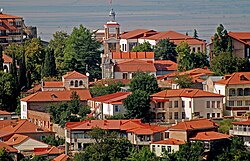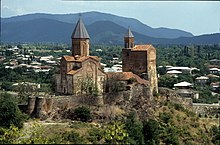User:Nvvchar/Kakheti
Kakheti
კახეთი | |
|---|---|
 Signagi an important cultural center in the region | |
 Map highlighting the modern political subdivision of Kakheti | |
| Country | |
| Capital | Telavi |
| Municipalities | 8 |
| Government | |
| • Governor | Irakli Shiolashvili |
| Area | |
• Total | 11,379 km2 (4,393 sq mi) |
| Population (2002) | |
• Total | 409,551 |
| • Density | 36/km2 (93/sq mi) |
| ISO 3166 code | GE-KA |
Kakheti (Georgian: კახეთი) is a region (Georgian: Mkhare) formed in the 1990s in eastern Georgia from the historical province of Kakheti and the small, mountainous province of Tusheti. Telavi is its capital. The region comprises eight administrative districts: Telavi, Gurjaani, Kvareli, Sagarejo, Dedoplistsqaro, Signagi, Lagodekhi and Akhmeta. Kakheti is bordered by the Russian Federation to the Northeast, Azerbaijan to the Southeast, and the Georgian regions of Mtskheta-Mtianeti and Kvemo Kartli to the west. The Georgian David Gareja monastery complex is partially located in this province and is subject to a border dispute between Georgian and Azerbaijani authorities. In the vicinity of Telavi, the vineyard valley, Sighnaghi, charming hill top town with many architectural monuments, the Alazani valley. Other important attractions here are: Tsinandali village, ancient churches such as Alaverdi Cathedral, castles like Batonistsikhe Castle; and mansions.
Viniculture, here which was the main activity when Georgia was part of the USSR continues to an equally economic activity in this region.
Geography
[edit]Beyond the modern-day administrative subdivision into the districts, Kakheti has traditionally been subdivided into four parts: Inner Kakheti (შიდა კახეთი, Shida Kakheti) to the east of Tsiv-Gombori mountain range, along the right bank of the Alazani River; Outer Kakheti (გარე კახეთი, Gare Kakheti) along the middle Iori River basin; Kiziq'i (ქიზიყი) between the Alazani and the Iori; Thither Area (გაღმა მხარი, Gaghma Mkhari) on the left bank of the Alazani. It also includes the medieval region of Hereti whose name has fallen into gradual oblivion since the 15th century.
Kakheti is an eastern province of Georgia which is delimited by hilly region of the Tusheti Province to its north, the mountains of Greater Caucasus on the east, Azerbaijan on the south, and the Kartli Province on the north. The province is drained by two river systems namely the Alazan River on the eastern part and the Iori River on the western part.[1]
Subdivision
[edit]The Kakheti region is divided into eight municipalities: These are the Telavi, the Akhmeta, the Gurjaani, the Kvareli, the Dedoplistskaro, the Lagodekhi, the Sagarejo, and the Sighnaghi.[2]
Telavi
[edit]Telavi Municipality has an area of 1,094 km and has a population 68,000.[2] The city, rich in viticulture, which is the capital city of Kakhet is located in the vine valley of Alazani which lies between the Gombori Mountains and the Caucasus.[3]
Akhmeta
[edit]The Akhmeta Municipality which is spread over an area of 2,248 km. Its population is 44,100.[2]
Gurjaani
[edit]The Gurjaani Municipality covers an area of 849 . The population under the minicpality is 73,200.[2]
Kvareli
[edit]The Kvareli Municipality is spread over an area of 1,000 km. The population here is 40,663.
Dedoplistskaro
[edit]The Dedoplistskaro Municipality's land area is 2,531 km and it has a population of 30,240.[2]
Lagodekhi
[edit]The Lagodekhi Municipality controls an area of 890 km which has a population of 50,300.
Sagarejo
[edit]The Sagarejo Municipality is spread over an area of 1,515 km and its population is 60,396. Sagarejo town, officially so since 1962, is the administrative center of the Sagarejo district and has a population of 12,600 as of 2012 census. It is also known as the Gare-Kakheti area, known in the 11th century as Tvali, which formed the outer limits of Kakheti. As it is under jurisdiction of the David Gareja monastery, it derived its name as Sagarejo "of Gareja".[2]
Sighnaghi
[edit]The Sighnaghi Municipality with an area of 1,251 km has a population of 42,652. It is the eastern most region and Sighnaghi town the smallest in the country, a picturesque town with historical buildings, churches, and cultural monuments. It is also the administrative center of the Sighnaghi district and has a population of 2,146 as of 2012. Tourism is an important activity as the region has many monuments and scenic places.[2][1] The town's name is derived from the Turkish word siğinak (shelter) meaning "shelter". The town's development was a safe haven against Lezgin and Persian invasions in the 18th century is credited to King Erekle II, is a picturesque in a hilly terrain and is 60 km away from Tiblisi. It has many architectural monuments, and "galleried houses" dated to 18th to 19th centuries, and the old world charm of the town has been maintained which are tourist attractions.[4]
History
[edit]The Kakheti was a monarchy with fully independent status or was partially independent in the past.[5] It became part of the united Georgian Kingdom from the start of the eleventh century, which lasted for less than ten years. It was only at start of the twelfth century Georgian King David the Builder (1089–1125) subsumed Kakheti into his Kingdom and retained this status for three centuries.[1] In the 1460s, When the United Georgian Kingdom was dismembered in 1460s, Kakheti was declared an independent monarchy.[1]
From the early 16th century till the early 19th century, Kakheti and its neighboring Kartli came under intermittent Iranian rule. In 1616, Shah Abbas deported hundreds of thousands of the ethnic Kakheti Georgian population to Iran and destroyed the region during his punitive campaign against Teimuraz I, his formerly most loyal subject. During all these centuries the region was an integral part of Iran and it supplied many notable generals, administrators, women and many hundred of thousands of peasants for the Iranian overlords. In 1762, the Kakhetian Kingdom was united with the neighboring Georgian Kingdom of Kartli, with the capital of the former, Telavi also capital of the Albanian Hereti, becoming the capital of the united Eastern-Georgian Kingdom of Kartl-Kakheti and assimilation of Albanians strengthened by church. Following the Treaty of Georgievsk and the sack of Tblisi by Agha Mohammad Khan, in 1801 the Kingdom of Kartl-Kakheti was annexed to the Tsarist Russian Empire. In 1801, Tsar Paul of Russia brought it under his domain. It remained with Russia till 1918, when in a revolution launched in Russia by Vladimir Ilyich Lenin, Kakheti, for a very short period attained an independent country status.[1] Russian suzerainty over Kakheti and the rest of Georgia became finalised with Qajar Iran in 1813 with the Treaty of Gulistan.[6]
After over a century of Russian rule over Kartli-Kakheti, following the Bolshevik revolution by Vladimir Ilyich Lenin in 1918, Kakheti became a part of independent Democratic Republic of Georgia. However, this independent status did not last long as Bolshevik armies invaded Georgia in 1921 and in 1922 it was part of the Union of Soviet Socialist Republics (USSR). With the USSR facing political disharmony form April, 1990, Georgia finally became an independent republic in 1992 and got the status as a member of the United Nations. Kakheti is a region in the republic of Georgia and Telavi is its capital.[1]
Climate
[edit]Demographics
[edit]Economy
[edit]Agriculture
[edit]Viniculture
[edit]Kakheti's eastern region has been known as the dominant wine producing area to such a popular extent that inviting guests to share a glass of wine is a common practice.[5]
Kakheti, which was well-known as the principal wine-growing region in the USSR, continues to be shaped by viniculture. Recently, archeological excavations discovered grape seeds that date back to 7000-6000 BC. Perhaps the most impressive Kakhetian winery is the Tsinandali wine works, which began production in 1865. It is located on property formerly owned by Alexandre Chavchavadze, the famous poet and businessman, who started the wine making business there.[1]
Forestry
[edit]Infrastructure
[edit]Landmarks
[edit]David Gareja monastery complex
[edit]The Georgian David Gareja monastery complex is partially located in this province and is subject to a border dispute between Georgian and Azerbaijani authorities.[7] The monastery is built partially in to the mountain face.[1]
Alaverdi Cathedral
[edit]Alaverdi Cathedral is 20km away to the northwest of Telavi which the local people hold in great reverence. The faced has very well designed arches with least ornamentation. There are 16 window in the cupola of the spacious church which provided natural lighting. Earthqaukes have caused damages tom the church many times during the 15th and 18th centuries. In the 19th century by covering the surface with white wash many frescoes were damaged which could only be recovered to certain extent after 1986. Over the western door entrance there are images of St George and dragon dated to the 16th century. The altar is deified with a statue of "The Virgin and Child" 11th century.[8] The Cathedral, which rises to height of 55 m, is reported to be the second tallest church in Georgia.[1]
Batonistsikhe Castle
[edit]Batonistsikhe castle was where the Kakhetian kings in the 17th and 18th centuries lived. It built by King Archil II when he moved his court in 1672 from Gremi to Telavi from Gremi. In the interior courtyard of the castle there is palace built in Persian architectural style. It was redone by Erekle II. There is a throne room where there are several portrait paintings related to the history of the monarchic period and among them the prominent one is of Erekle fixed above the throne. The castle also houses an ancient church and chapel (with markings of holes in the walls to fir firearms), which are in a dilapidated condition. These were built in 1758 during the reign of Erekle II. There are also art museum and history museum where exhibits on display are Georgian and western European paintings.[9]
Parks
[edit]The Lagodekhi National Park was the first national park which was established in 1912. The park has a rich diversity of flora and fauna.[1]
Travel information
[edit]The travel infrastructure in Kakheti is fast developing, since it is the most visited region of Georgia. One can choose to stay in a guest house, in a small and comfortable hotel, or a beautiful boutique-style hotel while traveling in this region. Telavi and Signagi are the most visited towns. Signagi was renovated three years ago. Until recently there were only some family hotels (simple rooms in a family-owned house with a shared bathroom), but now Signagi features several hotels.
See also
[edit]
Footnotes
[edit]- ^ a b c d e f g h i j "Kakheti". Smithsonian Institution. Retrieved 5 August 2015.
- ^ a b c d e f g "Telavi Municipality Government" (pdf). Office of Relations with International Foundations and NGO’s. Retrieved 6 August 2015.
- ^ "Introducing Telavi". Lonely Planet. Retrieved 6 August 2015.
- ^ "Introducing Sighnaghi". Lonely Planet. Retrieved 6 August 2015.
- ^ a b "Kakheti". Lonely Planet. Retrieved 6 August 2015.
- ^ Timothy C. Dowling (2 December 2014). Russia at War: From the Mongol Conquest to Afghanistan, Chechnya, and Beyond. ABC-CLIO. pp. 728–. ISBN 978-1-59884-948-6.
- ^ Michael Mainville (2007-05-03). "Ancient monastery starts modern-day feud in Caucasus". Middle East Times. Retrieved 2007-06-23.
- ^ {[Cite web|url=http://www.lonelyplanet.com/georgia-armenia-azerbaijan/georgia/kakheti/around-telavi/alaverdi-cathedral/sights/other/alaverdi-cathedral%7Ctitle=Alaverdi Cathedral|accessdate=20 August 2015|publissher=Lonely Planet}}
- ^ "Batonistsikhe Castle". Lonely Planet.
{{cite web}}: Unknown parameter|accesdate=ignored (|access-date=suggested) (help)
External links
[edit]- www.kakheti.net - information Kakheti region website
- Kakheti regional administration website
 Nvvchar/Kakheti travel guide from Wikivoyage
Nvvchar/Kakheti travel guide from Wikivoyage
41°45′N 45°43′E / 41.750°N 45.717°E
Category:Regions of Georgia (country) Category:Former provinces of Georgia (country) Category:Historical regions of Georgia (country)


